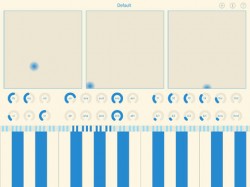 Developer Mod Phon Ltd has introduced Voxen – a new voice synthesizer for iPad.
Developer Mod Phon Ltd has introduced Voxen – a new voice synthesizer for iPad.
Voxen is a voice synthesizer. It’s designed not for realistic text-to-speech vocal effects, but for creating synthesized ‘singing voices’.
Here’s what the developer has to say about Voxen:
Voxen is *not* a text-to-speech system. You cannot provide it with lyrics and expect it to sing them. Voxen is a synthesizer that acoustically simulates a glottis and vocal tract, allowing you to manually control the sound. It synthesizes sounds, not words.
Because a human voice is more complex than nearly any other musical instrument, a synthesizer of human voices is also very complex. To control one can require the real-time manipulation and coordination of dozens of separate parameters.
If you are looking for something that creates a musical performance from a piece of sheet music and some lyrics on a scrap of paper, hire a good vocalist. On the other hand, if you are looking some new and different sounds, use Voxen.
No official demo is available at this point, but here’s an unofficial demo, by thesoundtestroom:
Features:
- Eight note polyphony
- Keyboard range of more than ten octaves
- Three X-Y touchpads
- Twenty-eight vertical linear knobs
- Choice of dark or light background colour
- Eight choices of foreground colour
- Save and load user-defined patches
Technical Background
Voxen is a polyphonic formant synthesizer. There are three banks of knobs which control, respectively, the voice, the voice envelope and the formants. The six voice knobs control provide a modified Klatt 1989 voicing source.
The ten voice envelope knobs control master amplitude and ADSR envelope for the voicing source and for a separate aspiration source. The remaining twelve knobs control the centre frequencies and bandwidths of the first four formants and the centre values and differences (spread) for a nasal formant/antiformant pair.
Each of the three X-Y touchpads controls a pair of parameters, f1 & f2, b1 & b2 and vibrato rate & vibrato depth.
Spectral tilt (or voice brightness) is controlled by the height you are touching the keys.
The overall aim of the user interface is to make it simple to control the many parameters in a live setting.
Voxen is available now for US $7.99 in the App Store.
If you’ve used Voxen, leave a comment and let us know what you think of it!

I think for a range of oddly cheesy (yet compelling) sounds, this looks pretty entertaining. I also like that it seems like you can create some glitchy sounds. These kinds of tones can add some humor to a track.
I wonder if you can get some nice gritty Tuvan monk tones.
I’ll pass on buying.
Wait, no MIDI? Guess I’ll be waiting for the update before purchasing; it’s not terribly useful if it can’t be sequenced.
I still want an iOS vocaloid.
I’d pay $0.99
@hurf, I am Eric, the developer of Voxen. MIDI and Audiobus support are both working in my development lab, but they need more testing to make sure that they as rock solid as I can make them before releasing to users. (After more than two weeks I have not yet had a single reported crash of the version that is currently available, and I would like to keep it that way.) Expect an update around mid-July (and even more in future).
@dv, I am sorry to hear that you believe that Voxen is only worth $0.99, especially as I suspect that you haven’t used it. Then again, if you believe that a voice synthesis tool that until now has only been available to speech scientists and psychoacoustics researchers, that is now running in real-time with live control on an iPad, is only worth $0.99 to you, well, it’s your loss. Experimenting with new and different sounds isn’t for everyone.
Still working on that update? It is a rather steep price (by IOS standards) for a synthesizer without ‘professional’ integration. I’ll be buying it when updated! Cheers.
I love the old school sound of it ! Reminds me of old Kraftwerk. I’m gonna buy it.